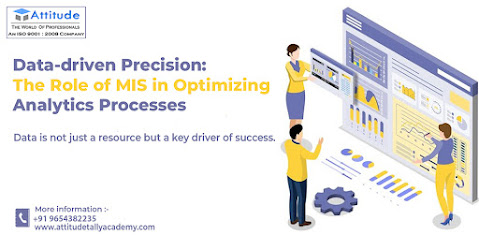Data-driven Precision: The Role of MIS in Optimizing Analytics Processes
Introduction
In the fast-paced world of
business, where data is generated at an unprecedented rate, leveraging the
power of information has become crucial for organizations aiming to stay ahead
of the competition. Two key aspects that play a pivotal role in this data-centric
landscape are "Data-driven Precision" and "Data-driven
Decision-Making." In this blog post, we'll explore the significance of
these concepts and how Management Information Systems (MIS) act as the linchpin
in optimizing analytics processes.
Understanding
Data-driven Precision
Data-driven precision
involves the strategic use of data to make informed and accurate decisions. In
the realm of analytics, precision is not just about collecting vast amounts of
data but rather extracting meaningful insights that can drive business strategies.
Organizations are increasingly recognizing the importance of precision in
decision-making, as it leads to more effective and targeted actions.
The Role of MIS
in Precision Analytics
Management Information
Systems (MIS) play a critical role in achieving data-driven precision. MIS act
as the backbone of an organization's information infrastructure, facilitating
the collection, processing, and analysis of data. By implementing robust MIS,
organizations can ensure that the right data is available at the right time and
in the right format, enabling precise decision-making.
Data Integration:
Building the Foundation
Data integration is the
process of combining and unifying data from different sources to provide a
comprehensive view. In the context of analytics, seamless data integration is
the bedrock upon which data-driven decision-making stands. It involves breaking
down data silos and creating a unified data ecosystem, ensuring that insights
are derived from a holistic perspective.
Breaking Down
Silos with MIS
MIS plays a crucial role in
data integration by seamlessly connecting disparate systems and databases. By
providing a centralized platform for data management, MIS breaks down silos
that often hinder effective decision-making. This integration allows for a more
comprehensive analysis of data, leading to richer insights and a clearer
understanding of business operations.
Data-driven: A
Strategic Imperative
Once data-driven precision
and data integration are in place, organizations can harness the power of
data-driven decision-making. This strategic approach involves using data
analytics to inform and guide business strategies, ensuring that decisions are
rooted in actionable insights.
Empowering
Decision-Makers with MIS
MIS empowers decision-makers
by providing real-time access to critical information. Through dashboards,
reports, and analytics tools, MIS enables leaders to make informed decisions
promptly. The integration of data from various sources ensures that decisions
are not made in isolation but are based on a comprehensive understanding of the
business landscape.
Conclusion
Data-driven precision and data integration
are integral components of a successful analytics strategy. The role of MIS in
optimizing analytics processes cannot be overstated. As organizations navigate
the complexities of a data-driven world, investing in robust MIS becomes a
strategic imperative. By embracing precision analytics, breaking down data
silos through integration, and leveraging MIS capabilities, organizations can
not only stay competitive but also thrive in an environment where data is a key
driver of success.




Comments
Post a Comment